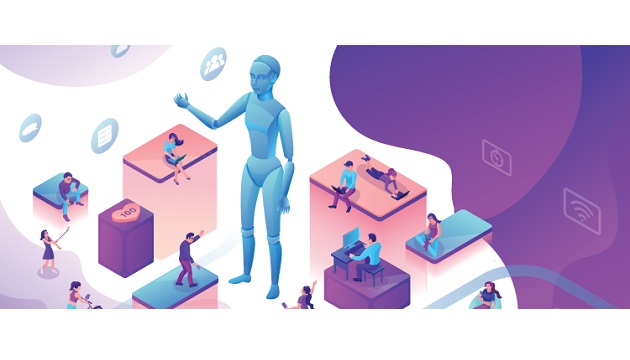Hey Joe, Please turn on! Now, imagine that Joe is your air conditioner, which can interact with you, and will follow your instructions. It will turn on and the same way, turn itself off. It’s all about your instructions which are required. Yes, this is potentially possible in the coming time. As AI Chatbot bandwagon has become an extreme, to imagine. With the unblocking of immense possibilities in the near future, interaction between machines and humans is on the verge of a radical shift.
Soon we will be able to instruct almost every object and make it respond to our presence, movements and voice commands. This will be facilitated through the Internet of Things or IoT, and computers through the Internet will enable a conversation. With simultaneous advances in technologies such as artificial intelligence and machine learning, these conversations will help devices to enhance our lives.
The main purpose of conversational technology is to enhance user experience and create value, so even if people use complex sentences or ask multiple pieces of questions where more than one request exists, then they can be easily processed with intelligent answers. If at all necessary, a customer representative can take over.
Virtual Assistants or Personal Assistants
The Seamless Conversation technology is revolutionizing several industries, as the enterprises working on such technology are making it possible for users to collect information at any time by talking to devices in a natural, human-like manner.
The most attractive feature about conversational technology is that users can utilize the technology anywhere, even when they are travelling. The device will converse with them in a realistic human voice, making it convenient for people to make use of the technology.
Chatbots have been around for a while but only now is this simple yet powerful technology receiving the kind of attention it deserves. A chatbot is a computer program designed to facilitate conversations between a human and a computer. The experience of interacting with AI chatbots makes one feel like interacting to a personal assistant rather than a virtual one.
AI Assistant…Many Platforms
Many top giants like Facebook, Slack, Skype, Apple, Microsoft and Amazon have already declared their platforms as a medium of conversational technology. They have also launched their range of virtual assistants. The best feature of virtual assistants is that they integrate well into different platforms like:
Smart Speakers
Speakers have gone a long way from providing just music to your ears. For example, they can answer your questions, set alarms, provide weather updates in real time, etc. Through smart speaker solutions, you can bring intelligent, intuitive speakers with voice-enabled home assistants. Both Google Home and Amazon Echo are examples of successful smart speakers that respond to user commands and instructions.
Instant Messaging Apps
Chatbots have revolutionized the way machine learning and artificial intelligence are being used to communicate with customers. A company that has been using this feature to its maximum potential is Facebook M and Messenger app. M is a new virtual assistant powered by AI and it is designed to answer every request that is put to it. Users can send a note to M, just like they would message anyone and that’s how the human element comes in.
Mobile OS or Desktop OS
Mobile phones have “smartOS” attached to them. The perfect examples are Apple’s Siri on iOS devices and Cortana on Microsoft Windows. Both these are intelligent personal assistants that can help get things done for your users. If people want to know the time in another country or the latest exchange rates, they can just tap on the VA and the information is at their fingertips.
Smartphones
Smartphones have become even smarter through AI. Take the case of Google Assistant on Google Pixel and Samsung Bixby on Samsung Galaxy S8 and S8+. These VAs are inbuilt in smartphones independent of the operating systems.
Bixby is a revolutionary VA from Samsung. Users can text, give voice commands or use touch to communicate with Bixby. The program is integrated into Samsung S8 and S8+. You can use it to make calls, search on the internet, set alarms change the settings in the phone.
Mobile Apps
Users can order what they need by using the voice command and leveraging the features offered through VA. Google Allo and Dom (from Domino’s Pizza) are perfect examples of this technology. Google Allo is an instant messaging app delivered for both iOS and Android mobile applications. It lets you send messages and emojis through stickers and huge doodles. The interesting part of the app is that your users can shout to emphasis their point or whisper if they wish so. Dom on the other hand is a voice-controlled assistant that helps people order pizza.
Wearables
Wearable devices have become more intuitive and manufacturers have come up with devices that respond through specific gestures, touch and voice commands. Users can set alarms, check their fitness level, monitor heartbeat, count calories and enjoy a number of features. Perfect example of this would be Android smart clothing, integrated with chips and connected via Bluetooth to user devices.
In the Catering Stock
The seamless conversation technology has immense potential in app development, retail, customer service and various other areas. Keeping that in mind, let’s deep dive in the various services offered by virtual assistants and in what fields they will be mostly useful:
Entertainment
The virtual voice personal assistant on your device would respond to your conversation, understand what you need and plays music, television shows or movies. The program even has the capacity to utilize your search history in order to understand your preferences and provide customized responses.
Shopping
Virtual assistants are like virtual salespersons. All your users need to do is to tell them the requirement and the VA would follow the responses to come back with items requested by the user. The VA can bring up items exactly as you want.
Information
VA can present the user with information regarding the weather, tell them which movies are playing where, the best restaurant to eat at, booking tickets and so on. For example, you can activate Siri by saying “Hello, Siri” and complete your request. The best thing about Siri is that it can integrate with third-party apps and follow queries to give accurate answers.
Household work
Virtual Assistants can help in household tasks as well. In the mornings, you can just lie in your bed, and command it to switch off the lights in your room or play music in another room. Or request it to read out the traffic and weather conditions.
Automotive
A significant portion of leads to car dealers come from online channels. Therefore conversion optimization is crucial for automotive companies. As a result, automotive companies are using chatbots like Kia’s Kian which can answer customers’ complex questions and dramatically increase conversions.
e-Commerce
Chatbots can add a new layer of interactivity to e-commerce, allowing customers to interact beyond menus and buttons. Major use cases are:
- Set price alerts
- Order physical goods like clothes with conversational commerce unlock more options
- Buy gifts
- Reserve services
What’s Next?
What we have discussed above has to mainly to do with Text Based conversational chatbots where messaging is the key medium to serve customers. But the future is going to be beyond text based user engagement. Most of the people are not comfortable typing and that audience is quite large. Typing is the limitation but everyone knows to talk at least in their local language. So future lies in making a Voice based conversational chatbot which can understand in multiple languages and respond back in the respective language which user is comfortable talking.
Having said that our system should be fault tolerant and reliable, as voice based conversation can go horribly wrong, user can’t navigate back and redo the entire conversation, so where you augment and mix text based approach has to be well thought through.
Success of Voice bots will be mainly be decided by how robust is it’s workflow design and how intelligently it can fall back to humans and text based conversation in case of any discrepancy in conversation.
Type of Voice Bots
Voice Bots can be bifurcated into two broader category:
- Hybrid Bots: Text+Voice based
- Voice Only Bots: Voice controlled devices
Voicebots behaves like conversational agent who acts like a personal assistant taking up your calls, reading messages, alerting about important events etc. They also integrates well with potential voice interface. A voice-first device is an always-on, they are intelligent piece of hardware with primary interface for interaction being audial both for input and output.
Text Vs Voice
Even though Voice is the most natural way of conversation but text due to huge acceptance of text based messaging has lead the way for Chatbot industry with more than three billion active user across top four messaging app, the opportunity to convert them into paying customers has been the main focus area for most of the business leaders.
Although, Voice and text bots have different input mechanism, they both are powered by NLP engine to function intelligently. An additional layer which serves a voice bot converts user’s voice into text before forwarding it to NLP engine. Similarly, the response is also converted into speech as output.








